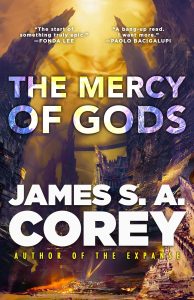The Mercy of God by James S.A. Corey: Review by Russell Letson
 The Mercy of Gods, James S.A. Corey (Orbit 978-0-31652-557-2, $30.00, 423 pp, hc) August 2024.
The Mercy of Gods, James S.A. Corey (Orbit 978-0-31652-557-2, $30.00, 423 pp, hc) August 2024.
The longer I review science fiction, the more I notice how it much it depends on recycling tropes – not just repeating but extending and varying and inverting them – and, I suspect, refitting them to reflect current anxieties or hopes, conscious or not. This time the recognition lights have been set flashing by the opening volume of The Captive’s War, a new series by James S. A. Corey (the collaborative identity of Daniel Abraham & Ty Franck). The Mercy of Gods doesn’t encompass quite as extensive a set of subgenres and motifs as their wide-ranging Expanse sequence does – not yet, anyway. It does, however, manage to braid together an apocalyptic First Contact; glimpses of space opera (or the results of one) and Stapledonian galactic history; contrasting human and inhuman psychologies; and a vision of humans defeated and dominated by an alien hegemony. And, as the series title promises, a war of resistance.
The initial setting is a lost-colony situation in a future an uncertain distance from today. 3,500 years earlier, humans appeared on Anjiin and, a century later, suffered what sounds like a civilization-breaking nuclear war that also broke their connection with their history. So Anjinn’s human population is already isolated, with only myth-filtered notions of how they and the rest of their biome got there. Their painfully rebuilt civilization is technologically sophisticated, but no match for the Carryx invasion fleet that appears in their solar system. The Carryx effortlessly brush aside all planetary defenses, cull one in eight of the population in an instant (to show their power and determination), and carry off samples of high-ability human elites to become part of the Carryx’s apparently endless, unstoppable wars of interstellar conquest.
The book opens (as do each of its five sections) with the voice of a Carryx administrator that establishes the inhuman thinking that drives them to dominate their environment and also announces that what follows is “the chronicle of [the Carryx’s] failure.” What unfolds thereafter is an elaboration and application of these hints.
The human viewpoint characters are from a group of scientists that is something between a research team and a family: the intensely focused and ambitious team leader Tonner; his right-hand associate (and lover) Else; the inseparable old-but-junior-status couple Nöl and Synna; the able but deeply depressive Jessyn; and so on. But the crucial figure is the most junior assistant and pot-washer, Dafyd Alkhor, not really a scientist but a political appointee with (as it proves) a profound gift for understanding relationships both human and alien. This talent is established in the early, preconquest chapters as he navigates the “intricate and opaque rules of behavior and… rigidly enforced though ill-defined hierarchy of status” of the academic social world.
There is one more important viewpoint character: the “swarm,” an artificial-intelligence entity sent to spy by some enemy of the Carryx. It inhabits, alters, and overwhelms the body and mind of a host as it gathers data, killing the body when it leaves but retaining remnant revenants of the personalities it has absorbed. It was present on Anjiin before the conquerors arrived and will host-hop in order to travel with the kidnapped humans, all the while seeking a way to transmit its information to those it serves.
At the heart of the story is captivity: the interstellar cattle-car conditions of transportation; the strange prison-camp/world-city where dozens of alien species serve the Carryx in a multitude of specialized ways; the revelation of the rules that govern the conquered; and the various kinds of adjustment to servitude. And all along, there is a growing recognition of the nature of their captors, driven primarily by Dafyd’s determination to make sense of what he sees and to eventually use it against the Carryx – though at a cost.
The conditions of that captivity are strange and apparently contradictory. The voyage to the Carryx world-city is profoundly miserable, but once there the researchers are given not only tolerable quarters in its giant ziggurats but some of their old equipment and a project to work on – interestingly related to their previous research on incompatible biomes – with the understanding that it is also a test to determine whether humans can be useful, and that “usefulness is survival.” The ziggurat is aswarm with dozens of subject species, among which are rivals who also must demonstrate their usefulness, which leads to a nasty conflict and an even nastier resolution by the Carryx.
Each member of the research team is affected differently by captivity, violence, loss, and deracination, but Dafyd’s response is to try to understand, and when he acquires a translation device, his conversations with members of other species show not only the pattern of Carryx conquest and domination but the variety of responses to it. What he hears from them is haunting and chilling.
We love them and we live. We eat their leavings and we smile and they give us our draft of pleasure…. Do as we have done. It is the best life that remains to you.
And another:
I will not tell you my name. Whatever it is you’re planning will fail and all of your kind will burn. Go away. We will not burn with you. Go away.
And another:
History? I have no history…. Nothing here has a history except for the Carryx. I don’t. You don’t…. You should stop. I don’t like talking to you anymore.
A number of things kept going through my mind as I read. First, of course, I also couldn’t not think of the behavior and culture of the Nazi regime, particularly in the portrait of blitzkrieg, culling, occupation, imprisonment, exploitation, and resistance. There’s also an echo of the Roman Empire’s conquer-absorb-exploit model for establishing hegemony, though with a terrifyingly chilling deployment of genocidal and scorched-planet practices that make imperial Rome look like the UN. And from there it is a short step to the entire human history of colonialism, territorial aggression, occupation, and enslavement of conquered populations. (There are hints that Anjiin’s humans recapitulated these practices in their long climb back to technological civilization.)
On the science-fiction end, I recalled the title and situation of William Tenn’s Of Men and Monsters (aka The Men in the Walls), followed by a substantial catalogue of other tales of humankind-conquered/used/domesticated/drafted: Frederik Pohl & C.M. Kornbluth’s Wolfbane, Thomas Disch’s The Puppies of Terra, Pohl’s The Other End of Time sequence, and, more recently, Greg Bear’s War Dogs sequence and Adrian Tchaikovsky’s Final Architecture trilogy. From there it’s a short step to the consideration of what a “monster” is, of what is being modeled in a book about a confrontation between humans and entities that are powerful, utterly rational, and literally inhuman.
What behavior is it that strikes us as “monstrous”? The book’s initial backward-looking “final statement” by the “keeper-librarian of the human moiety of the Carryx” is the start of a thread that reveals how they see the world and themselves. Their ideology, rooted in a coherent and clearly articulated world view, is not opaque but merely (initially) unseen, and elaborated in those section-leading segments of the keeper-librarian’s “final statement.” Here is one lesson:
The truth is this: That which is, is….
When a primitive of your own kind cut a branch from a tree and carved the wood into a tool… whatever your will designed – you placed no moral judgment on the act, nor should you have. To do so would have been perverse. The tree had no power to stop you, and so it became a tool in your hand.
What you did to a tree branch, we did with you and countless others before you. Why me? is not something the universe ever answers.
Elsewhere there is the recurring metaphor of weeding a garden, and everywhere the vision of how creatures make use of other creatures, and that this is the way of the universe, whether or not anyone recognizes it.
All this runs through a novel busy with incidents ordinary and horrific, with alien landscapes and marvels, with sharp observations of how people behave on the outside and feel on the inside, while building toward a nightmare vision of retribution in which worlds will burn. But that would seem to be the matter of later books. For this one, surviving subjugation is the problem, and the solution is not pretty.
Interested in this title? Your purchase through the links below brings us a small amount of affiliate income and helps us keep doing all the reviews you love to read!
Russell Letson, Contributing Editor, is a not-quite-retired freelance writer living in St. Cloud MN. He has been loitering around the SF world since childhood and been writing about it since his long-ago grad school days. In between, he published a good bit of business-technology and music journalism. He is still working on a book about Hawaiian slack key guitar.
This review and more like it in the September 2024 issue of Locus.
 While you are here, please take a moment to support Locus with a one-time or recurring donation. We rely on reader donations to keep the magazine and site going, and would like to keep the site paywall free, but WE NEED YOUR FINANCIAL SUPPORT to continue quality coverage of the science fiction and fantasy field.
While you are here, please take a moment to support Locus with a one-time or recurring donation. We rely on reader donations to keep the magazine and site going, and would like to keep the site paywall free, but WE NEED YOUR FINANCIAL SUPPORT to continue quality coverage of the science fiction and fantasy field.
©Locus Magazine. Copyrighted material may not be republished without permission of LSFF.








